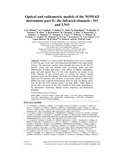Optical and radiometric models of the NOMAD instrument part II: the infrared channels - SO and LNO
| dc.contributor.author | Thomas, I. R. | |
| dc.contributor.author | Vandaele, A.C. | |
| dc.contributor.author | Robert, S. | |
| dc.contributor.author | Neefs, E. | |
| dc.contributor.author | Drummond, R. | |
| dc.contributor.author | Daerden, F. | |
| dc.contributor.author | Delanoye, S. | |
| dc.contributor.author | Ristic, B. | |
| dc.contributor.author | Berkenbosch, S. | |
| dc.contributor.author | Clairquin, R. | |
| dc.contributor.author | Maes, J. | |
| dc.contributor.author | Bonnewijn, S. | |
| dc.contributor.author | Depiesse, C. | |
| dc.contributor.author | Mahieux, A. | |
| dc.contributor.author | Trompet, L. | |
| dc.contributor.author | Neary, L. | |
| dc.contributor.author | Willame, Y. | |
| dc.contributor.author | Wilquet, V. | |
| dc.contributor.author | Nevejans, D. | |
| dc.contributor.author | Aballea, L. | |
| dc.contributor.author | Moelans, W. | |
| dc.contributor.author | De Vos, L. | |
| dc.contributor.author | Lesschaeve, S. | |
| dc.contributor.author | Van Vooren, N. | |
| dc.contributor.author | Lopez-Moreno, J.-J. | |
| dc.contributor.author | Patel, M. R. | |
| dc.contributor.author | Bellucci, G. | |
| dc.contributor.author | NOMAD Team, NOMAD Team | |
| dc.date.accessioned | 2018-03-05T19:42:16Z | |
| dc.date.available | 2018-03-05T19:42:16Z | |
| dc.date.issued | 2016-02-16 | |
| dc.identifier.citation | Thomas, I.R., A.C. Vandaele, S. Robert, E. Neefs, R. Drummond, F. Daerden, S. Delanoye, B. Ristic, S. Berkenbosch, R. Clairquin, J. Maes, S. Bonnewijn, C. Depiesse, A. Mahieux, L. Trompet, L. Neary, Y. Willame, V. Wilquet, D. Nevejans, L. Aballea, W. Moelans, L. De Vos, S. Lesschaeve, N. Van Vooren, J.-J. Lopez-Moreno, M.R. Patel, G. Bellucci, and the NOMAD Team. "Optical and radiometric models of the NOMAD instrument part II: the infrared channels – SO and LNO." Optics Express 24 (2016): 3790-3805. DOI:10.1364/OE.24.003790. | en_US |
| dc.identifier.issn | 1094-4087 | |
| dc.identifier.uri | http://hdl.handle.net/10680/1383 | |
| dc.description.abstract | NOMAD is a suite of three spectrometers that will be launched in 2016 as part of the joint ESA-Roscosmos ExoMars Trace Gas Orbiter mission. The instrument contains three channels that cover the IR and UV spectral ranges and can perform solar occultation, nadir and limb observations, to detect and map a wide variety of Martian atmospheric gases and trace species. Part I of this work described the models of the UVIS channel; in this second part, we present the optical models representing the two IR channels, SO (Solar Occultation) and LNO (Limb, Nadir and Occultation), and use them to determine signal to noise ratios (SNRs) for many expected observational cases. In solar occultation mode, both the SO and LNO channel exhibit very high SNRs >5000. SNRs of around 100 were found for the LNO channel in nadir mode, depending on the atmospheric conditions, Martian surface properties, and observation geometry. | en_US |
| dc.description.sponsorship | NOMAD has been made possible thanks to funding by the Belgian Science Policy Office (BELSPO) and financial and contractual coordination by the ESA Prodex Office. The research was performed as part of the “Inter university Attraction Poles” programme financed by the Belgian government (Planet TOPERS). UK funding is acknowledged under the UK Space Agency grant ST/I003061/1. | |
| dc.description.uri | https://www.osapublishing.org/oe/abstract.cfm?uri=oe-24-4-3790 | |
| dc.language.iso | en | en_US |
| dc.publisher | Optics Express | en_US |
| dc.rights | info:eu-repo/semantics/openAccess | |
| dc.title | Optical and radiometric models of the NOMAD instrument part II: the infrared channels - SO and LNO | en_US |
| dc.type | Article | en_US |
| dc.identifier.doi | 10.1364/OE.24.003790 |

